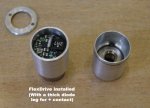IgorT
0
- Joined
- Oct 24, 2007
- Messages
- 4,177
- Points
- 0
Re: FS: Key Chain CR2 Kit! - SCHWEET!
How do you know your FlexDrive is putting out 185mA?
- Is it on the diode or on the dummy load when you see that it's putting out current?
- What is the Vf of the dummy load?
- Do you have an adjustable PSU, so that you could power the dummy from the Flex, while CAREFULLY turning the voltage from 5.5V down to 2.5V to see if the current THROUGH the dummy stays the "SAME"?
I've had some problems with FlexDrives, but usually they all had a good reason, none of them ever gave up on me just like that. :thinking:
It COULD be a damaged IC, if it was trying to push current through air at one time (loose connection during testing?), resulting in the chip trying to do something, starting out OK, but failing?
I'm just guessing.. I'd have to see it, test it, to figure out what the problem is.
But there are not many possibilities:
- broken pot (unlikelly in your case from description)
- short from soldering / solder drops left on driver (again unlikelly)
- damaged chip from no load operation (most likelly? altho it does have a Zener to protect from that?!?)
I always test every driver on a dummy by measuring the current and varying the input voltage from MAX to MIN several times (and sometimes by letting it run for an hour) the entire time checking that the current is not changing!
On a FlexDrive, if the current changes more than 2-4mA (from 2.5-5.5V) or if the current changes erratically, something is wrong! Often the only solution is to use another FlexDrive...
I always have a bunch of my own dead drivers from when i make them, and kill them during testing, by forgetting to check all connections and the chip burns out boosting to 25V... Only solution is to replace the chip. Since it has no legs it's not fun, but luckily it only has six pins underneath!
The chip on FlexDrive has TEN pins underneath, that is something i would not attempt to solder by hand! Especially since the PCB is not adjusted for hand soldering...
EDIT: Battery voltage under 2.5V can cause strange behavior... Problem is, often you can't measure battery voltage under load, and no load voltage tells you little... Old Lithium Primaries could be the cause in theory...
OK, got some air and went back in to double check things.
With 185mA from a MicroDrive powered by a 9V bench supply, the diode is a happy diode (in other words, it's not toast).
With 185mA from a FlexDrive powered by a 3V CR2, it returns to pseudo-toast mode.
I'm confused and open to suggestions.
How do you know your FlexDrive is putting out 185mA?
- Is it on the diode or on the dummy load when you see that it's putting out current?
- What is the Vf of the dummy load?
- Do you have an adjustable PSU, so that you could power the dummy from the Flex, while CAREFULLY turning the voltage from 5.5V down to 2.5V to see if the current THROUGH the dummy stays the "SAME"?
I've had some problems with FlexDrives, but usually they all had a good reason, none of them ever gave up on me just like that. :thinking:
It COULD be a damaged IC, if it was trying to push current through air at one time (loose connection during testing?), resulting in the chip trying to do something, starting out OK, but failing?
I'm just guessing.. I'd have to see it, test it, to figure out what the problem is.
But there are not many possibilities:
- broken pot (unlikelly in your case from description)
- short from soldering / solder drops left on driver (again unlikelly)
- damaged chip from no load operation (most likelly? altho it does have a Zener to protect from that?!?)
I always test every driver on a dummy by measuring the current and varying the input voltage from MAX to MIN several times (and sometimes by letting it run for an hour) the entire time checking that the current is not changing!
On a FlexDrive, if the current changes more than 2-4mA (from 2.5-5.5V) or if the current changes erratically, something is wrong! Often the only solution is to use another FlexDrive...
I always have a bunch of my own dead drivers from when i make them, and kill them during testing, by forgetting to check all connections and the chip burns out boosting to 25V... Only solution is to replace the chip. Since it has no legs it's not fun, but luckily it only has six pins underneath!
The chip on FlexDrive has TEN pins underneath, that is something i would not attempt to solder by hand! Especially since the PCB is not adjusted for hand soldering...
EDIT: Battery voltage under 2.5V can cause strange behavior... Problem is, often you can't measure battery voltage under load, and no load voltage tells you little... Old Lithium Primaries could be the cause in theory...
Last edited:










